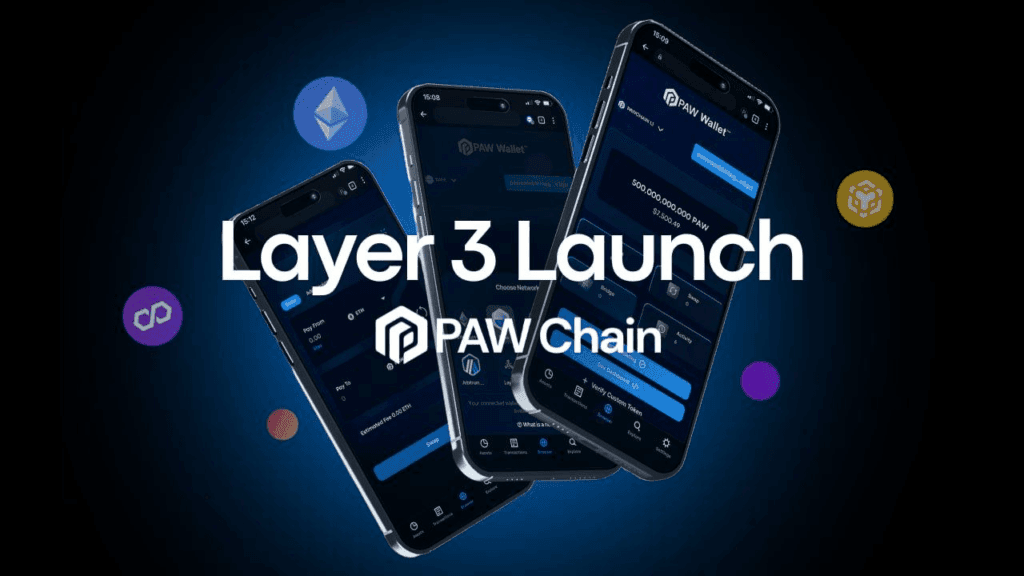

In the ever-evolving world of blockchain, the terms Layer 1 and Layer 2 are commonly used to describe the foundation of networks and their scalability solutions. But there’s a new player in town—Layer 3 technology—and it’s poised to take blockchain innovation to the next level.
Layer 3, particularly on the PAW Chain, acts as a “superhighway” for blockchain data and transactions, enabling seamless interaction across networks. Let’s look into what Layer 3 is, how it works on PAW Chain, and why it’s a game-changer for the blockchain ecosystem.
Layer 1, Layer 2, and Now Layer 3
To understand Layer 3, it’s essential to know where it fits into the blockchain hierarchy:
Layer 1
Layer 1 refers to the base blockchain protocols like Bitcoin or Ethereum. It handles the core functions such as transaction processing, consensus mechanisms, and security. However, Layer 1 networks often face scalability challenges, such as slow transaction speeds and high costs during peak usage.
Layer 2
Layer 2 solutions, like Ethereum’s Optimistic Rollups or Bitcoin’s Lightning Network, are built on top of Layer 1. They focus on enhancing scalability by processing transactions off-chain or batching them to reduce congestion and fees.
Layer 3
Now comes Layer 3, which operates above Layer 2. Instead of focusing solely on scalability, it targets cross-chain interoperability, user experience, and application-specific functionalities. On PAW Chain, Layer 3 creates a seamless bridge for communication and interaction across various blockchain networks, breaking down silos that limit blockchain’s potential.
The Role of Layer 3 Technology on PAW Chain
PAW Chain’s Layer 3 solution aims to enhance blockchain’s usability and connectivity. Here’s how it works:
1. Enhanced Interoperability
Layer 3 allows blockchains to communicate effortlessly. For instance, a user on Ethereum can interact with a dApp on Binance Smart Chain without needing complex conversions or manual integrations. This interoperability makes PAW Chain a hub for multi-chain applications.
2. Simplified User Experience
One of the most significant barriers to blockchain adoption is complexity. Layer 3 abstracts the technical challenges, offering a smooth experience for users. Whether it’s transferring assets or executing smart contracts, Layer 3 simplifies these processes, making blockchain more accessible.
3. Application-Specific Layers
Layer 3 focuses on the needs of decentralized applications (dApps). Developers can create customized layers tailored to their dApps, offering unique functionalities and improved performance.
4. A Highway for Data and Transactions
Think of PAW Chain’s Layer 3 as a high-speed highway for blockchain data. It ensures that transactions are processed faster and more efficiently, even when they involve multiple chains.
Why Layer 3 Matters
Layer 3 technology is more than just a technical upgrade—it’s a paradigm shift that can redefine how we use blockchain. Here’s why it matters:
- Cross-Chain Ecosystems: Layer 3 supports the vision of a truly interconnected blockchain ecosystem, where users and developers can move seamlessly across networks.
- Increased Efficiency: By handling cross-chain data flow, Layer 3 reduces bottlenecks and transaction costs.
- Broader Adoption: Simplified interfaces and improved interoperability encourage mainstream adoption by removing entry barriers.
PAW Chain: Leading the Layer 3 Revolution
PAW Chain stands out as a pioneer of Layer 3 technology. Its architecture is designed to maximize scalability and usability without compromising security. By integrating Layer 3 functionalities, PAW Chain is building an ecosystem where blockchain interoperability becomes the norm.
Key Features of PAW Chain’s Layer 3
- Cross-Network Bridges: Effortless asset transfer between chains.
- Custom dApp Layers: Developers can optimize apps for performance and usability.
- Smart Routing: Transactions automatically take the most efficient path, reducing fees and time.
These features make PAW Chain a strong contender in the blockchain space and a promising solution for real-world use cases.
Applications of Layer 3 Technology
Layer 3 technology has the potential to transform industries such as:
- DeFi (Decentralized Finance): Enables liquidity across multiple chains for better yields.
- Gaming: Connects gaming ecosystems, allowing asset sharing and interoperability.
- Supply Chain: Provides transparent tracking across different blockchain networks.
- NFTs: Facilitates cross-chain NFT marketplaces and trading.
Conclusion: Welcome to the Layer 3 Era
Layer 3 technology is a game-changer, bridging the gaps that have long hindered blockchain’s full potential. On PAW Chain, Layer 3 acts as the ultimate enabler, making blockchain interaction faster, simpler, and more interconnected than ever before.
As the blockchain industry evolves, PAW Chain’s leadership in Layer 3 solutions positions it at the forefront of innovation. Whether you’re a developer, investor, or blockchain enthusiast, the possibilities with Layer 3 are endless.
So, buckle up—it’s time to embrace the Layer 3 revolution and explore the future of blockchain with PAW Chain!
FAQs
Q1: What is the main difference between Layer 2 and Layer 3?
Layer 2 focuses on scalability by reducing congestion on Layer 1 blockchains. Layer 3, however, targets cross-chain interoperability and enhanced user experience, making blockchain interactions seamless across networks.
Q2: How does PAW Chain utilize Layer 3 technology?
PAW Chain uses Layer 3 to enable interoperability, simplify user experiences, and optimize decentralized applications for efficiency and performance.
Q3: Why is Layer 3 important for blockchain adoption?
Layer 3 reduces complexity, enhances connectivity, and makes blockchain applications more accessible, paving the way for mainstream adoption.
Explore the possibilities with PAW Chain’s Layer 3 and be part of the blockchain future!




